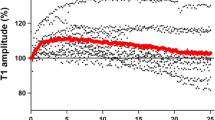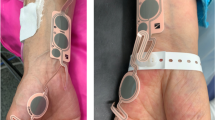Abstract
The twitch responses evoked from the abductor hallucis muscle (AHM) and the adductor pollicis muscle (APM) were examined simultaneously in 20 anesthetized patients following a single bolus intravenous administration of 0.04 mg·kg−1 of vecuronium bromide. The mean onset time of vecuronium-induced depression of AHM twitch responses was significantly slower than that of APM twitch responses (4.9±1.5 minvs 3.7±1.2 min, mean±SD,P<0.001), and when the clinical duration times of vecuronium were compared, AHM twitch responses recovered more quickly than APM twitch responses (15.3±4.1 minvs 19.6±6.7 min,P<0.01), although there was no statistically significant difference in the spontaneous recovery time between AHM and APM (9.8±2.9 minvs 10.0±3.6 min). It is concluded that the twitch responses of AHM may be a useful monitor of neuromuscular blockade in anesthetized patients in whom setting the blockade monitor on the patient's arms is difficult, although monitoring of twitch response of AHM is less sensitive than that of APM in case of vecuronium administration.
Similar content being viewed by others
References
Itagaki T, Tai N, Katsumata N, et al. (1988) Comparison between a new acceleration transducer and a conventional force transducer in the evaluation of twitch responses. Acta Anaesthesiol Scand 32:347–349
Goat VA, Yeung ML, Blankeney C, et al. (1976) The effect of blood flow upon the activity of gallamine triethiodide. Br J Anaesth 48:69–73
Padykula HA, Gauthier GF (1970) The ultrastructure of the neuromuscular junctions of mammalian red, white, and intermediate skeletal muscle fibers. J Cell Biol 46:27–41
Paton WDM, Zaimis EJ (1951) The action of d-tubocurarine and of dechamethonium on respiratory and other muscles in the cat. J Physiol 112:311–331
Choi WW, Gergis SD, Sokoll MD (1984) The effects of d-tubocurarine, pancuronium and atracurium on the responses of gastrocnemius and soleus muscles in the cat. Acta Anaesthesiol Scand 28:608–611
Secher NH, Rube N, Secher O (1982) Effect of tubocurarine on human soleus and gastrocnemius muscles. Acta Anaesthesiol Scand 26:231–234
Johnson MA, Polgar J, Weightman D, et al. (1973) Data on the distribution of fibre types in thirty-six human muscles: An autopsy study. J Neurol Sci 18:111–129
Buzello W, Schluermann D, Pollmaecher T, et al. (1987) Unequal effects of cardiopulmonary bypass-induced hypothermia on neuromuscular blockade from constant infusion of alcuronium, d-tubocurarine, pancuronium, and vecuronium. Anesthesiology 66:842–846
Miller RD, Agoston S, van der Pol F, et al. (1978) Hypothermia and the pharmacokinetics and pharmacodynamics of pancuronium in the cat. J Pharmacol Exp Ther 207:532–538
Suzuki H, Tai K, Katsumata N, et al. (1986) Clinical evaluation of vecuronium bromide in collaboration with nine departments of anesthesiology (in Japanese, with English abstract). Masui (Jpn J Anesthesiol) 35:100–113
Author information
Authors and Affiliations
About this article
Cite this article
Suzuki, T., Suzuki, H., Katsumata, N. et al. Evaluation of twitch responses obtained from abductor hallucis muscle as a monitor of neuromuscular blockade: Comparison with the results from adductor pollicis muscle. J Anesth 8, 44–48 (1994). https://doi.org/10.1007/BF02482753
Received:
Accepted:
Issue Date:
DOI: https://doi.org/10.1007/BF02482753




